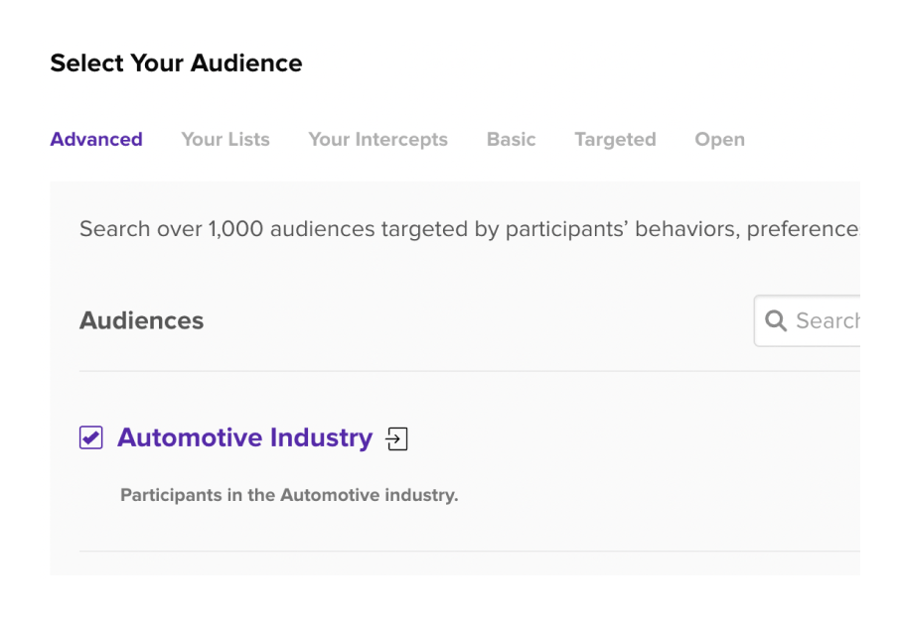Take Your Audience Segmentation One Step Further
You’ve gone through the useful exercise of segmenting your CRM data to understand your best customer segments. Use Helio to uncover pain points unique to each segment, and the messages most likely to resonate.


Uncover pain points unique to specific audience segments
Audience segmentation helps identify distinct pain points within different customer groups, allowing you to address these specific challenges with targeted solutions, building stronger customer relationships.
Rapidly test key messages to audience segments
Develop and test segment-specific messages with targeted audience panels. Experiment, optimize, and refine those messages so they resonate with their intended audience segment.
Discover new ways your customers use your product
Learn how diverse customer segments use your product. Who knows, you may find hidden use-cases and opportunities for product improvement or feature development.
Map to UX Metrics

Brand Impressions
Reaction

Frequency of Use
Usefulness
Business questions that can be addressed with audience segmentation analyses
Here are some common questions product and marketing leaders ask that can be addressed by testing hypotheses about differences between audience segments:
Audience segmentation is key to knowing which features or product improvements matter most to specific customer segments. Helio allows you to divide a broader audience into smaller, well-defined groups based on criteria that move beyond basic demographics and dive into criteria that really matter, like behaviors and preferences.
With Helio, you can create targeted surveys and studies that reveal what each segment values most. This data-driven approach ensures you’re focusing on the right features for the right people.
Tailor your product development and marketing strategies to address the specific demands of each segment. This improves customer satisfaction and boosts engagement and loyalty by making your offerings more relevant and personalized.

Understanding how different customer segments respond to pricing strategies and discounts starts with effective audience segmentation. By breaking down your audience into specific groups based on characteristics like spending habits and price sensitivity, Helio supports you in tailoring your pricing strategies to each segment’s preferences and needs.
You can conduct targeted surveys to see how different segments react to various pricing models and discounts. This helps in identifying which strategies are most effective for each group.
Using Helio’s insights, you can refine your pricing approaches to maximize appeal and profitability. For instance, you might discover that one segment is more responsive to loyalty discounts, while another prefers upfront price reductions. Tailoring your offers in this way not only boosts sales but also enhances customer satisfaction and loyalty.
Start with audience segmentation to find out what messaging or content resonates best with each segment. By dividing your audience based on interests, behaviors, and demographics, you can tailor your messages to their needs and preferences.
Through targeted surveys, Helio helps identify the type of content and messaging that each segment finds most engaging. This allows you to craft personalized messages that speak directly to different groups.
Using Helio, you can improve engagement by delivering relevant content to each segment. Whether it’s a blog post, email campaign, or social media update, personalized messaging that addresses each group’s specific interests and pain points will drive higher engagement and loyalty.
To determine which marketing channels are most effective for reaching specific customer segments, audience segmentation is essential. By categorizing your audience based on demographics, behaviors, and preferences, you can identify the best channels to engage each group.
With Helio, you can run targeted surveys to see where each segment spends their time online and which channels they prefer. This insight helps you allocate your marketing resources more effectively.
Armed with Helio data, you can tailor your marketing efforts to the most effective channels for each segment. Whether it’s social media, email, or traditional media, using the right channels ensures your message reaches the right people, boosting engagement and conversion rates.
How to test and validate findings from audience segmentation analyses

Create a survey in minutes
Helio’s intuitive platform and expert-made templates makes survey creation a breeze. Choose from 12 different question types and upload any kind of media

Select an audience that represents your target segment
Use the search bar to find existing audiences, or select an industry and browse a selection of over 1,000 audiences. If you don’t see an audience you’re looking for, we can create a custom one for you.

Conduct surveys and tests with your other audience segments
Send the same (or different) surveys to audiences that best represent your other audience segments and note your observations.

Compare & contrast observations across audience segments
Surface differences across your segments: pain points, use-cases, emotional responses to messages, and even click-test data.
Market segmentation is a natural result of the vast differences among people
Test Template Example
FAQs
Audience segmentation is the process of dividing a larger target audience into smaller, more specific groups or segments based on shared characteristics, interests, or behaviors.
Audience segmentation allows businesses to tailor their marketing strategies, messages, and products to specific groups, increasing the relevance and effectiveness of their efforts.
Segmentation criteria can include demographics (age, gender, income), psychographics (lifestyle, values), behavior (purchase history, website activity), geographic location, and more.
The choice of criteria depends on your business goals and the nature of your products or services. It’s important to align segmentation criteria with your target audience’s characteristics and preferences.
Segmentation can lead to improved customer engagement, higher conversion rates, more relevant marketing messages, and increased customer retention.
Data can be collected through surveys, website analytics, customer feedback, social media insights, purchase history, and third-party data sources.
No, audience segmentation can benefit businesses of all sizes. Even small businesses can use segmentation to target their marketing efforts more effectively.
Yes, you can target multiple segments within a single campaign by tailoring the messaging or content to appeal to each specific group.
Success can be measured by tracking key performance indicators (KPIs) such as conversion rates, revenue, customer retention, and customer satisfaction within each segment.



